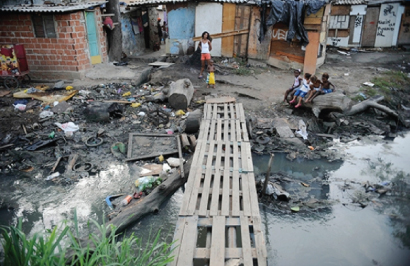
Basic sanitation: the concern should be proportional to the size of the problem
To understand the inequality in the supply of infrastructure and basic sanitation services, just follow the paths of poverty
09/01/2017
Sewage in the streets, creeks and rivers is a typical Brazilian picture, especially in the poorest regions
Lack of basic sanitation – a chronic and historical problem in the Country – exposes the population to diseases. Deficiency in sewage treatment and adequate disposal still causes thousands of diseases, mainly among children. For the sanitary engineer at the Collective Health Department at Fiocruz-PE, André Monteiro, the Brazilian sanitation conditions, are generally, terrible. The sanitary expression of these conditions are evident, just look at the neglected diseases. And most recently, the microcephaly/Zika and other arboviral diseases tragedy, he stresses while adding that these tragedies would not exist if we had good sanitation.
The basic sanitation problem reaches from its diffusion increase, as well as greater democratization of public services. However, our water supply networks are poor and socially unequal, he criticizes while pointing the supply intermittence is another great problem, besides a high rate of water loss in the distribution system – around 40% of the treated water becomes sewage before reaching the houses. The sewage network has a low coverage rate; its treatment is around a third of what is collected.
The expert says open sewage in the streets, creeks and rivers are a typical Brazilian picture. Overall in the poorest regions. Besides this, services of solid residue collection and urban drainage contribute to worsen this scenario, for example, strengthening arboviral diseases transmission, as Zika, by the Culex. Brazilian social inequality is expressed by these services. They are postcards of Brazilian inequality, he observes. And these regional inequalities are striking. While the most developed cities in the Country, as São Paulo and Rio de Janeiro, report sewage treatment levels in the order of 93%, other capitals as Belém (7.7%) and Macapá (5.5%), cannot enjoy the same privilege.
To the sanitary engineer, sewage inequality reflects social inequality. Between regions, within regions, states and cities. To understand the access inequality to sanitation infrastructure and sewage, just follow the paths of poverty. Average income, education, inhabitation and urbanization conditions have a direct association, he complains while adding that public resources allocation is scarce for the poor, and tragedies multiply. Brazil ranks 10th place among 17 Latin-American countries in sanitation. The Country is behind, for example, neighbors Venezuela, Bolivia and Peru, according to Trata Brasil Institute. At this pace, experts say the federal government will not reach the goal to make basic sanitation universally available until 2033.
Does cholera threaten Brazil?
Considering lack of basic sanitation a great threat for public health and that choleras main transmission is through contaminated water, the most susceptible group for infection is formed by the poorest, since these people live in areas where basic sanitation is precarious and they usually do not have hygienic habits. The spread and mortality potential of this disease can be expressed by the 1994 epidemic in the Democratic Republic of Congo, in Goma refugee camp, where in a single month, the amount of cases reached from 58,000 to 80,000 killing over 23,800 people. In Haiti, nearly 800 cholera cases were reported in one week after being struck by hurricane Matthew, according to the World Health Organization (WHO).
Asked about the matter, the Health Ministry said hygiene and water and sewage treatment are the main prevention actions. The Board also said Brazil has not reported autochthonous cases of the disease since 2006. The last epidemic in the Country took place from 1991 to 2000, when 2,035 people died, according to data from VE-Cólera. Since then there were no more deaths. Still according to the note, the situation is under control, but authorities remain alert, monitoring Vibrio cholerae. Suspected cases require immediate notification and investigation for the severity and possible manifestation as an outbreak, making immediate control measures necessary. The investigation must take place as fast as possible by the official health organ qualified for the task (health center or post, hospital, Health Secretary epidemiological surveillance).…










